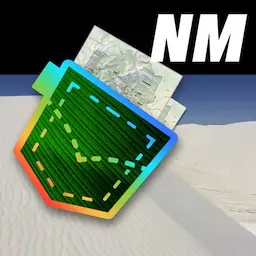"White dune landscape, White Sands National Monument, 2016." by U.S. National Park Service , public domain
Desert in ColorWhite Sands |
Brochure 'Desert in Color' about Wildflowers of White Sands National Park (NP) in New Mexico. Published by the National Park Service (NPS).
National Park Service
U.S. Department of the Interior
White Sands
White Sands National Monument
Desert in Color
Bloom
T
here is no single “best time” to see desert wildflowers. Different types
of plants bloom at different times. At White Sands National Monument,
flowers bloom later than those in the surrounding desert foothills due to the
pool of cold air from the mountains that settles into the basin at night.
Annual Wildflowers
Most wildflowers begin blooming
around the middle of April. The
most common early bloomers in the
dunefield include the sand verbena,
Hartweg’s sundrops, desert mentzelia,
and White Sands mustard. In midMay, these are joined by gypsum
centaury, white evening primrose,
and greenthread. Some plants
may continue to produce flowers
throughout the summer, especially
after monsoon-season rains.
Pepperweed, a white-flowered
mustard that is often overlooked,
grows throughout the residential area
and dune margins. It is the hardiest
wildflower in the park and is the
first plant to bloom in the spring,
usually around the first of March,
earlier in warmer years. It blooms
throughout the summer and into the fall.
Pepperweed has been seen in bloom in
the monument every month of the year.
Spring Wildflowers
Spring is when all of the small
wildflowers begin to bloom and the
grasses and bushes begin to turn
green. Soaptree yucca is the star of
the spring flowers. It grows tall and
can easily be spotted throughout the
dunes. Its flowers are white and have
the appearance of upside down tulips.
Another big contender in the spring
is prairie gentian. This wildflower is
easiest to spot at the beginning of the
Dune Life Nature Trail. There is also
a white version of the plant that will
bloom next to the purple one.
Summer Wildflowers
Many wildflowers are seen in the
summer but few are robust enough to
bloom during the high temperatures.
These plants have smaller flowers
like the gypsum centaury and desert
mentzelia. They can be found growing
in the interdunal areas throughout the
entire dunefield.
Fall Color
Even though most of the plants at
White Sands bloom in the spring and
summer, there is still color to be seen
in the fall. The fall colors can begin
to appear as early as October and last
through November. This is the time
when the Rio Grande cottonwood
trees begin to turn a beautiful orange
and the skunkbush sumacs start to
turn a vibrant red. These plants can be
found throughout the first five miles
of Dunes Drive.
For more information on White Sands, visit http://www.nps.gov/whsa.
Desert Mentzelia
Gypsum Centaury
Globemallow
Blooms: Late spring - late summer
Blooms: Early summer
Blooms: Late summer - early fall
Mountain Pepperweed
Rubber Rabbitbrush
Hartweg’s Sundrops
Lepidium montanum
Ericameri nauseosa
Calylophus hartwegii
Blooms: Early spring - late summer
Blooms: Late fall - early winter
Blooms: Early spring - late summer
Tree Cholla
Catchfly Prairie Gentian
Cowpen Daisy
Mentzelia multiflora
Centaurium maryannum
Cylindropuntia imbricata
Blooms: Late summer - early fall
Soaptree Yucca
Yucca elata
Blooms: Late spring - late summer
Eustoma exaltatum
Sphaeralcea sp.
Verbesina encelioides
Blooms: Late spring - summer
Blooms: Late summer - early fall
Rio Grande Cottonwood
Skunkbush Sumac
Populus deltoides ssp. wislizeni
Color: Early fall
Rhus trilobata
Color: Late fall
Note: Blooming seasons may vary due to more or less rainfall.
Revised 04/03/2016




